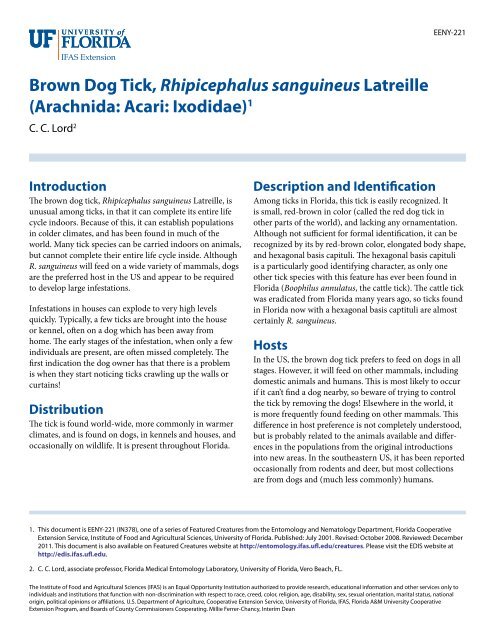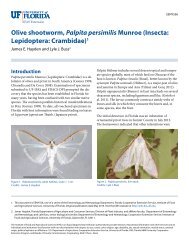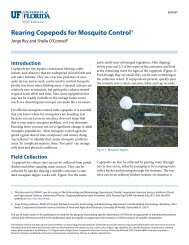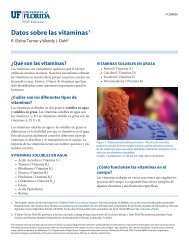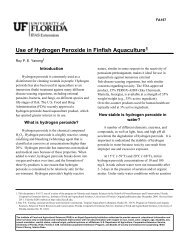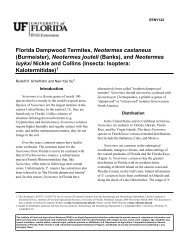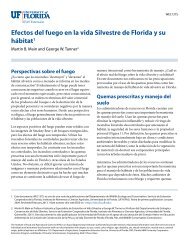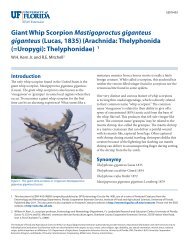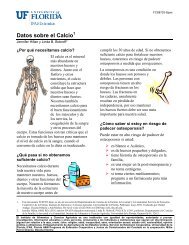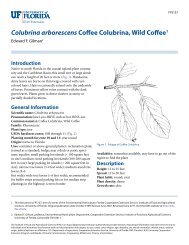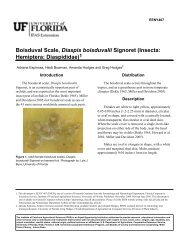Brown Dog Tick, Rhipicephalus sanguineus Latreille - EDIS ...
Brown Dog Tick, Rhipicephalus sanguineus Latreille - EDIS ...
Brown Dog Tick, Rhipicephalus sanguineus Latreille - EDIS ...
You also want an ePaper? Increase the reach of your titles
YUMPU automatically turns print PDFs into web optimized ePapers that Google loves.
<strong>Brown</strong> <strong>Dog</strong> <strong>Tick</strong>, <strong>Rhipicephalus</strong> <strong>sanguineus</strong> <strong>Latreille</strong><br />
(Arachnida: Acari: Ixodidae) 1<br />
C. C. Lord 2<br />
Introduction<br />
The brown dog tick, <strong>Rhipicephalus</strong> <strong>sanguineus</strong> <strong>Latreille</strong>, is<br />
unusual among ticks, in that it can complete its entire life<br />
cycle indoors. Because of this, it can establish populations<br />
in colder climates, and has been found in much of the<br />
world. Many tick species can be carried indoors on animals,<br />
but cannot complete their entire life cycle inside. Although<br />
R. <strong>sanguineus</strong> will feed on a wide variety of mammals, dogs<br />
are the preferred host in the US and appear to be required<br />
to develop large infestations.<br />
Infestations in houses can explode to very high levels<br />
quickly. Typically, a few ticks are brought into the house<br />
or kennel, often on a dog which has been away from<br />
home. The early stages of the infestation, when only a few<br />
individuals are present, are often missed completely. The<br />
first indication the dog owner has that there is a problem<br />
is when they start noticing ticks crawling up the walls or<br />
curtains!<br />
Distribution<br />
The tick is found world-wide, more commonly in warmer<br />
climates, and is found on dogs, in kennels and houses, and<br />
occasionally on wildlife. It is present throughout Florida.<br />
EENY-221<br />
1. This document is EENY-221 (IN378), one of a series of Featured Creatures from the Entomology and Nematology Department, Florida Cooperative<br />
Extension Service, Institute of Food and Agricultural Sciences, University of Florida. Published: July 2001. Revised: October 2008. Reviewed: December<br />
2011. This document is also available on Featured Creatures website at http://entomology.ifas.ufl.edu/creatures. Please visit the <strong>EDIS</strong> website at<br />
http://edis.ifas.ufl.edu.<br />
2. C. C. Lord, associate professor, Florida Medical Entomology Laboratory, University of Florida, Vero Beach, FL.<br />
Description and Identification<br />
Among ticks in Florida, this tick is easily recognized. It<br />
is small, red-brown in color (called the red dog tick in<br />
other parts of the world), and lacking any ornamentation.<br />
Although not sufficient for formal identification, it can be<br />
recognized by its by red-brown color, elongated body shape,<br />
and hexagonal basis capituli. The hexagonal basis capituli<br />
is a particularly good identifying character, as only one<br />
other tick species with this feature has ever been found in<br />
Florida (Boophilus annulatus, the cattle tick). The cattle tick<br />
was eradicated from Florida many years ago, so ticks found<br />
in Florida now with a hexagonal basis captituli are almost<br />
certainly R. <strong>sanguineus</strong>.<br />
Hosts<br />
In the US, the brown dog tick prefers to feed on dogs in all<br />
stages. However, it will feed on other mammals, including<br />
domestic animals and humans. This is most likely to occur<br />
if it can’t find a dog nearby, so beware of trying to control<br />
the tick by removing the dogs! Elsewhere in the world, it<br />
is more frequently found feeding on other mammals. This<br />
difference in host preference is not completely understood,<br />
but is probably related to the animals available and differences<br />
in the populations from the original introductions<br />
into new areas. In the southeastern US, it has been reported<br />
occasionally from rodents and deer, but most collections<br />
are from dogs and (much less commonly) humans.<br />
The Institute of Food and Agricultural Sciences (IFAS) is an Equal Opportunity Institution authorized to provide research, educational information and other services only to<br />
individuals and institutions that function with non-discrimination with respect to race, creed, color, religion, age, disability, sex, sexual orientation, marital status, national<br />
origin, political opinions or affiliations. U.S. Department of Agriculture, Cooperative Extension Service, University of Florida, IFAS, Florida A&M University Cooperative<br />
Extension Program, and Boards of County Commissioners Cooperating. Millie Ferrer-Chancy, Interim Dean
Figure 1. Life stages of the brown dog tick, <strong>Rhipicephalus</strong> <strong>sanguineus</strong><br />
<strong>Latreille</strong>. Clockwise from top right, larva, male, female, nymph.<br />
Credits: James Newman, University of Florida<br />
Figure 2. Hexagonal basis capituli, an identifying character for the<br />
brown dog tick, <strong>Rhipicephalus</strong> <strong>sanguineus</strong> <strong>Latreille</strong>.<br />
Credits: James Newman, University of Florida<br />
Life Cycle<br />
Ixodid ticks require three blood meals to complete development;<br />
once each as a larva, nymph and adult. The brown<br />
dog tick is a 3-host tick; this indicates that it leaves the host<br />
to develop and molt between the larval, nymphal and adult<br />
stages. Each stage must locate a host; in a domestic environment<br />
this may result in feeding on the same dog (if there is<br />
only one or a few dogs present), but there is an opportunity<br />
for the same tick to feed on three different hosts.<br />
A fully blood-fed female brown dog tick can lay up to 5000<br />
eggs; the number of eggs laid depends on the size of the<br />
tick and the amount of blood she ingested. The length of<br />
time each stage feeds, and the time required for development<br />
and molting, are very dependent on temperature.<br />
Feeding and development times are generally faster at<br />
warmer temperatures. Survival is generally higher at cooler<br />
temperatures and higher relative humidity, but these ticks<br />
are tolerant of a wide range in conditions.<br />
Figure 3. Life cycle of the brown dog tick, <strong>Rhipicephalus</strong> <strong>sanguineus</strong><br />
<strong>Latreille</strong>.<br />
Credits: James Newman, University of Florida<br />
An adult female will feed on the host for around one week,<br />
then drop off the host and find a secluded place for egg<br />
development. Cracks and crevices in houses, garages and<br />
dog runs are ideal locations. She will start laying as soon as<br />
four days after she completes feeding and drops off the host,<br />
and can continue to lay for as long as 15 days. As she lays<br />
the eggs, she passes them over her porose areas (specialized<br />
areas on the back of the basis capituli), to coat them in<br />
secretions which protect the eggs from drying out. After<br />
she finishes laying her eggs, she dies. The larvae hatch two<br />
to five weeks later, and begin to quest, or look for a host. All<br />
stages of this tick prefer dogs, although they will feed on<br />
other mammals. Larvae feed for three to seven days, then<br />
take about two weeks to develop into nymphs. The nymphs<br />
then feed for five to 10 days and again take about two weeks<br />
to develop into adults. As adults, both males and females<br />
will attach to hosts and feed, although the males only feed<br />
for short periods. The overall cycle can be completed in just<br />
over two months, but frequently will take longer if there<br />
are few hosts available or in cold temperatures. <strong>Tick</strong>s are<br />
2
notoriously long-lived, and can live as long as three to five<br />
months in each stage without feeding.<br />
In Florida, the cycle can occur year-round both inside<br />
houses and in outside kennels and dog runs.<br />
Figure 4. Female brown dog tick, <strong>Rhipicephalus</strong> <strong>sanguineus</strong> <strong>Latreille</strong>,<br />
laying eggs.<br />
Credits: James Newman and Leah LeFevre, University of Florida<br />
Frequently, people report having different types of ticks, or<br />
adults and “babies”. In fact, generally what they are seeing<br />
are engorged and unengorged ticks or different stages. <strong>Tick</strong>s<br />
increase in size dramatically while feeding; engorged ticks<br />
are considerably larger than unengorged ticks. The different<br />
stages (larva, nymph and adult) are progressively larger in<br />
size. Many features used to identify the stages and sexes<br />
are difficult to see without a microscope. Larvae have only<br />
six legs, while nymphs and adults have eight. Males and<br />
females are difficult to distinguish without examining them<br />
microscopically, but males take only small blood meals<br />
while females take large meals and increase in size. Nymphs<br />
are distinguishable from adults primarily by size, but this<br />
is not reliable and needs to be confirmed by microscopic<br />
examination.<br />
Medical and Veterinary<br />
Significance<br />
High levels of infestation can cause skin irritation and damage<br />
in dogs, and the population can reach pest proportions<br />
in houses and kennels. In the US, R. <strong>sanguineus</strong> is a vector<br />
of disease in dogs; canine ehrlichiosis (Ehrlichia canis) and<br />
canine babesia (Babesia canis). These rarely cause disease<br />
in humans; only a few cases are known. In dogs, symptoms<br />
of canine ehrlichiosis include lameness and fever; those for<br />
babesiosis include fever, anorexia and anemia. Both have<br />
Figure 5. Engorged (right) and unengorged or flat nymphs of the<br />
brown dog tick, <strong>Rhipicephalus</strong> <strong>sanguineus</strong> <strong>Latreille</strong>. The increased size<br />
results from ingesting large volumes of blood.<br />
Credits: James Newman, University of Florida<br />
Figure 6. Nymph (larger tick) and larvae of the brown dog tick,<br />
<strong>Rhipicephalus</strong> <strong>sanguineus</strong> <strong>Latreille</strong>, on a dime.<br />
Credits: James Newman and Leah LeFevre, University of Florida<br />
been found in Florida. In parts of Europe, Asia and Africa<br />
R. <strong>sanguineus</strong> is a vector of Rickettsia conorii, known locally<br />
as Mediterranean spotted fever, boutonneuse fever, or tick<br />
typhus. Ripicephalus <strong>sanguineus</strong> has not been shown to<br />
transmit the bacterium which causes Lyme disease.<br />
Chapters 2 and 5 of the National Public Health Pest Control<br />
Manual (http://entomology.ifas.ufl.edu/fasulo/vector)<br />
provide details on diseases transmitted by ticks.<br />
Management<br />
The best management strategy is prevention of infestations<br />
in the house or kennel. Discuss tick control with your<br />
veterinarian; preventing engorgement of the ticks on dogs<br />
3
is critical to management of the tick and the well-being of<br />
the dog. Treatments with fipronil (in sprays and spot-ons),<br />
amitraz (often in flea and tick collars), permethrin (sprays<br />
and shampoos) and deltamethrin (shampoos) have been<br />
reported as effective. Regular treatment will minimize the<br />
chances of a dog picking up a tick and the tick successfully<br />
feeding. Treatment will also reduce attachment by other<br />
species of tick, such as the American dog tick or the<br />
blacklegged tick. Once an infestation has started, thorough<br />
treatment of the dogs is critical and may need to be<br />
repeated several times. Follow your veterinarian’s instructions<br />
and the directions on the any tick control product you<br />
use. <strong>Dog</strong>s should be examined regularly and attached ticks<br />
removed and disposed of. It may be necessary to treat the<br />
house or kennel, paying particular attention to cracks and<br />
crevices. Pest control operators should be consulted. Other<br />
mammals should be monitored and treated if necessary,<br />
but be careful about treatments used on cats. Some tick<br />
and flea treatments for dogs are poisonous in cats. People<br />
should check themselves regularly; although rare in the US<br />
this species will bite humans. DEET (found in many insect<br />
repellents) does repel these ticks, but may not be practical<br />
if an infestation is inside a house. Use according to label<br />
directions.<br />
For additional information see the Insect Management<br />
Guide for <strong>Tick</strong>s (http://edis.ifas.ufl.edu/ig088).<br />
The earlier the infestation is discovered and addressed, the<br />
easier it will be to control. Monitoring and grooming dogs,<br />
particularly upon return from kennels or locations where<br />
other dogs are present, is the best way to detect infestations<br />
early.<br />
Selected References<br />
Dame, D. A. and T. R. Fasulo (2001, July 16). Mites and<br />
<strong>Tick</strong>s. Public Health Pesticide Applicator Training Manual.<br />
http://entomology.ifas.ufl.edu/fasulo/vector/chapter_<br />
05.htm (26 June 2003).<br />
Estrada-Pena, A. and F. Ascher. 1999. Comparison of an<br />
amitraz-impregnated collar with topical administration of<br />
fipronil for prevention of experimental and natural infestations<br />
by the brown dog tick (<strong>Rhipicephalus</strong> <strong>sanguineus</strong>).<br />
Journal of the American Veterinary Medical Association.<br />
214: 1799-1803.<br />
Fasulo, T. R. (2002). Fleas and <strong>Tick</strong>s and Wasps and Bees.<br />
Bug Tutorials. University of Florida/IFAS. CD-ROM. SW<br />
159.<br />
Fasulo, T.R. W. Kern, P. G. Koehler, and D. E. Short. (2005).<br />
Pests In and Around the Home. Version 2.0 University of<br />
Florida/IFAS. CD-ROM. SW 159.<br />
Folz, S. D., K. A. Ash, G. A. Conder and D. L. Rector. 1986.<br />
Amitraz: a tick and flea repellent and tick detachment drug.<br />
Journal of Veterinary Pharmacology and Therapeutics. 9:<br />
150-156.<br />
Fox, M. T. and T. J. Sykes. 1985. Establishment of the<br />
tropical dog tick, <strong>Rhipicephalus</strong> <strong>sanguineus</strong>, in a house in<br />
London. Veterinary Record. 116: 661-662.<br />
Franc, M. and M. C. Cadiergues. 1999. Activity of a<br />
deltamethrin shampoo against Ctenocephalides felis and<br />
<strong>Rhipicephalus</strong> <strong>sanguineus</strong> in dogs. Veterinary Parasitology.<br />
81: 341-346.<br />
Koch, H. G. 1982a. Oviposition of the brown dog tick<br />
(Acari: Ixodidae) in the laboratory. Annals of the Entomological<br />
Society of America. 75: 583-586.<br />
Koch, H. G. 1982b. Seasonal incidence and attachment sites<br />
of ticks (Acari: Ixodidae) on domestic dogs in southeastern<br />
Oklahoma and northwestern Arkansas, USA. Journal of<br />
Medical Entomology. 19: 293-298.<br />
Koch, H. G. and M. D. Tuck. 1986. Molting and survival<br />
of the brown dog tick (Acari: Ixodidae) under different<br />
temperatures and humidities. Annals of the Entomological<br />
Society of America. 79: 11- 14.<br />
Kumar, S., S. Prakash, M. P. Kaushik and K. M. Rao. 1992.<br />
Comparative activity of three repellents against the ticks<br />
<strong>Rhipicephalus</strong> <strong>sanguineus</strong> and Argas persicus. Medical and<br />
Veterinary Entomology. 6: 47-50.<br />
Rhodes, A. R. and B. R. Norment. 1979. Hosts of <strong>Rhipicephalus</strong><br />
<strong>sanguineus</strong> (Acari: Ixodidae) in northern Mississippi,<br />
USA. Journal of Medical Entomology. 16: 488-492.<br />
Smith, R. D., D. M. Sells, E. H. Stephenson, M. Ristic and D.<br />
L. Huxsoll. 1976. Development of Ehrlichia canis, causative<br />
agent of canine ehrlichiosis, in the tick <strong>Rhipicephalus</strong><br />
<strong>sanguineus</strong> and its differentiation from a symbiotic richettsia.<br />
American Journal of Veterinary Research. 37: 119-126.<br />
Sonenshine, D. E. 1993. Biology of <strong>Tick</strong>s. Vol. 2. Oxford<br />
University Press, NY. 465 pages.<br />
Sweatman, G. K. 1967. Physical and biological factors<br />
affecting the longevity and oviposition of engorged<br />
4
<strong>Rhipicephalus</strong> <strong>sanguineus</strong> female ticks. Journal of Parasitology.<br />
53: 432-445.<br />
5


